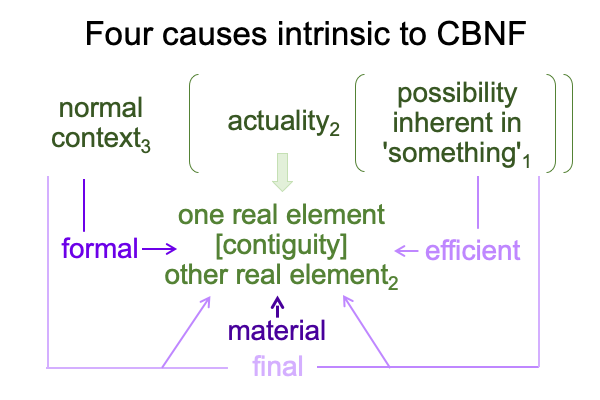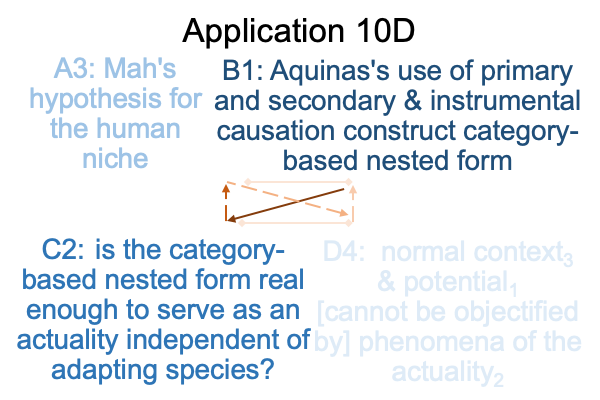0824 Even though the bill is paid, and the public curtain closes on this examination of Tabaczek’s book, the flavors of the dessert still linger.
The associations in chapter seven suggest a retrogression into the house of evolutionary creation.
At the same time, the associations intimate a moment when the author can go direct into the house of theistic evolution.
0825 How so?
Can a scientist observe and measure the actuality2 within a category-based nested form?
Yes.
What about the normal context3 and potential1?
No, the scientist can only observe and measure phenomena associated with a category-based nested form. Phenomena go with the actuality2. The noumenon associates to the normal context3 and potential1.
0826 Well, if that is the case, and if the Kantian slogan of the noumenon applies (that is, the noumenon [cannot be objectified as] its phenomena), then the normal context3 and potential1 [cannot be objectified by] the actuality2.
But, this is what human constantly do. Humans understand actuality2 in terms of its2 normal context3 and potential1. So humans intuitively sense that the normal context3 and potential1 can be objectified by the corresponding actuality2.
0827 Indeed, the fact that the four causes work together to elucidate a category-based nested form constitutes one reason why Aristotle’s four causes are superior to attributions to the four elements (earth, water, fire and air).

Aristotle’s four causes are built into human nature.
0827 So, let me re-imagine the dessert, even as I digest it.
To start, a theologyagent (B1) realizes that Aquinas’s use of primary, secondary and instrumental causation in evolutionary creation can be formulated in terms of a category-based nested form.
Next, the agent of theology (B1) begins to appreciate the reason why Aristotle’s four causes are so appealing. The four causes work together to elucidate all three elements of a category-based nested form. The category-based nested form is the first step in understanding.
Yes, the category-based nested form is a purely relational structure that is independent of the human mind.
But, it seems that the category-based nested form is embedded in the human body and brain.
0828 A question appears in the sciencemirror (C2), asking, “Is our capacity to intuitively construct category-based nested forms adaptive? Is the human niche the potential of category-based nested forms, in particular, and triadic relations, in general?”
0829 An answer is already prepared for the slot for scienceagent (A3).
Razie Mah’s e-book, The Human Niche, is available at smashwords and other e-book venues.
The claim?
The human niche is the potential of triadic relations.
0830 This is what theistic evolution can produce that evolutionary creation cannot.
In order to taste what Tabaczek’s meal (B1) does to the mirrorscience (C2) consider two of Razie Mah’s blogs (A3), both of which claim that current modern evolutionary theory cannot tell us how humans evolved to recognize the noumenon, the thing itself, through implicit abstraction.
Current modern evolutionary theory cannot tell us where we came from.
Current modern evolutionary theory cannot tell us what we evolved to be.
Current modern evolutionary theory cannot tell us what went wrong.
0831 Here is a picture of one Greimas square for the optics of Tabaczek’s mirror.

0832 Oh, the two blogs?
Looking at Mark S. Smith’s Book (2019) “The Genesis of Good and Evil”, appears in Razie Mah’s blog from Jan 13 through 31, 2022.
Looking at Carol Hill’s Article (2021) “Original Sin with Respect to Science”, appears from February 7 through 25, 2022.
With that said, I thank Dr. Mariusz Tabaczek O.P. for this wonderful banquet for thought.
But, my work is not done. I now retreat to Comments on Mariusz Tabaczek’s Arc of Inquiry (2019-2024) in order to examine chapter eight.
